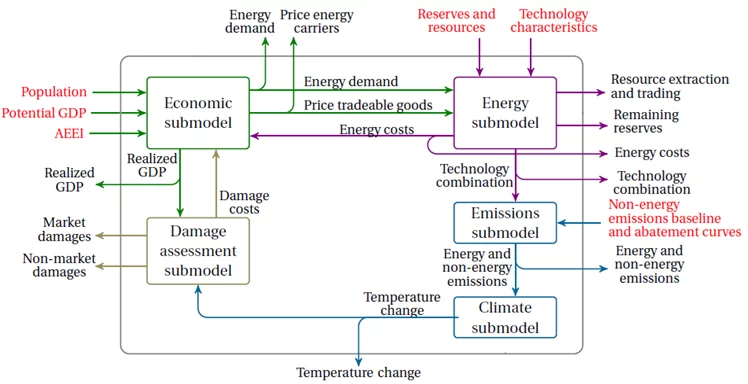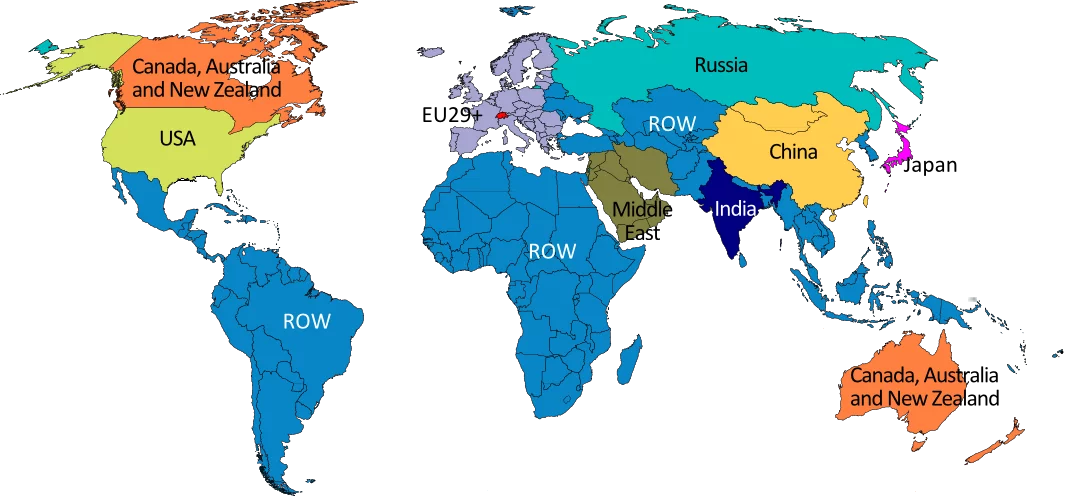MERGE-ETL is an integrated assessment model combining a bottom-up description of the energy system disaggregated into electric and non-electric sectors, a top-down model based on a macroeconomic production function, and a simplified climate cycle.
MERGE-ETL has been progressively developed by PSI from the MERGE model of Manne et al. (1995)). The integrated approach in MERGE-ETL accounts for linkages between economic activity and the energy sector, such that the model determines endogenously energy demands, prices, technology choice and economic output. The model has a top-down economy description with bottom-up description of the energy system. In addition, technological learning is represented in MERGE-ETL by two-factor learning curves for technology investment costs, applying the paradigm of technology clusters described in Seebregts et al. (2000) (Kypreos 2007; Magne et al. 2010; Marcucci and Turton 2011). The regional disaggregation in MERGE-ETL has been revised recently to provide a more contemporary representation of important political groupings (Marcucci, 2012).
Below is a high-level overvioew of the structure of the MERGE-ETL model:
The current geographical resolution of the model is given below:
Recent work on the model has included the review and update of energy technology input assumptions based on recent literature estimates; review and update of the climate sub-model to better reflect recent estimates of climate sensitivity, the carbon cycle and the influence of the ocean on temperature change; and implementation of increased detail in the representation of nuclear technologies and fuels, given recent developments and interest in nuclear policy (Marcucci, 2012). MERGE-ETL has been applied to explore uncertainty related to global climate and nuclear policies in the wake of the Fukushima disaster, focusing on the impact on Switzerland (Marcucci and Turton 2012). MERGE-ETL was also used in the AMPERE project.
Documentation
References
Kypreos, Socrates (2007). A MERGE model with endogenous technological change and the cost of carbon stabilization. Energy Policy 35: 5327–5336.
Magne, Bertrand, Socrates Kypreos, and Hal Turton (2010). Technology options for low stabilization pathways with MERGE. The Energy Journal. Special Issue 1 31: 83–108.
Manne, Alan, Robert Mendelsohn, and Richard Richels (1995). MERGE: A model for evaluating regional and global effects of GHG reduction policies. Energy Policy 23: 17–34.
Marcucci, Adriana. (2012) Realizing a Sustainable Energy System in Switzerland in a Global Context. Ph.D. thesis, ETH Zurich.
Marcucci, A. and H. Turton (2012). Swiss Energy Strategies under Global Climate Change and Nuclear Policy Uncertainty, The Swiss Journal of Economics and Statistics, Vol. 148 (2), pp. 317-345.
Marcucci, A. and H. Turton (2011). Analyzing Energy Technology Options for Switzerland in the Face of Global Uncertainties: An Overview of the MERGE model, NCCR climate Research paper 2011/05.
Seebregts, A., Bos S., Kram T., and G. Schaeffer (2000). Endogenous Learning and Technology Clustering: Analysis with MARKAL Model of the Western European Energy System. International Journal of Energy Issues 14: 289–319.


